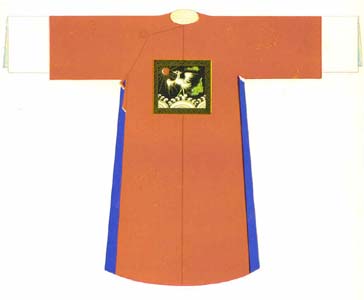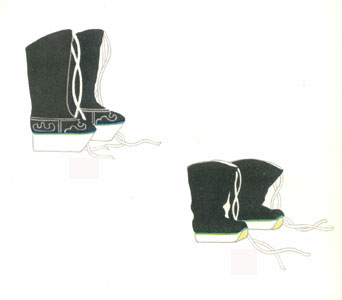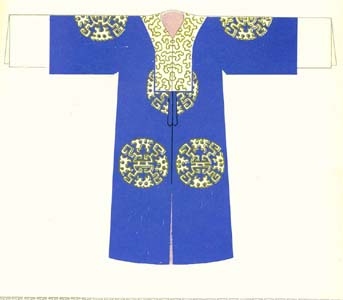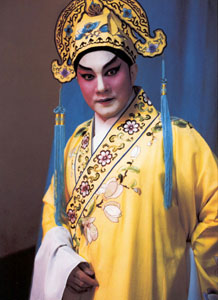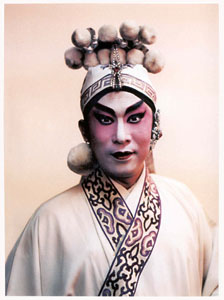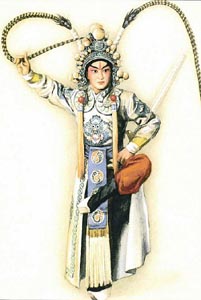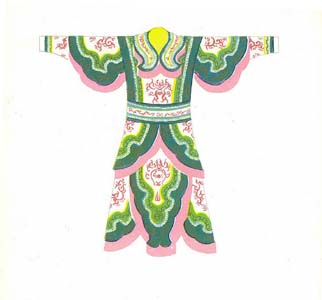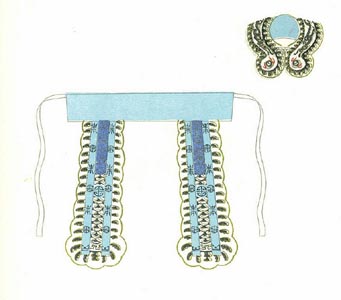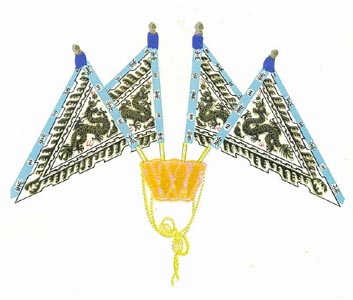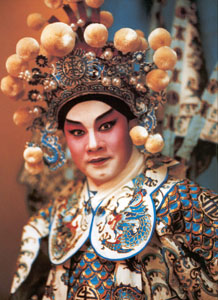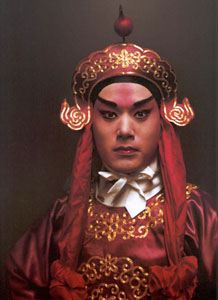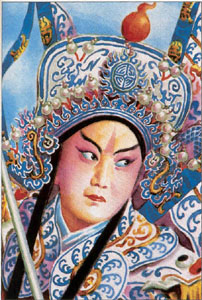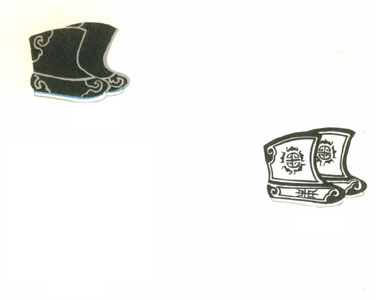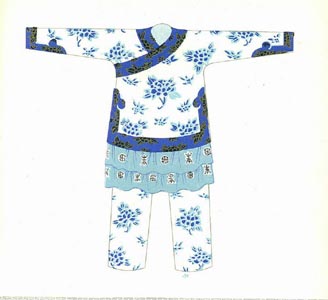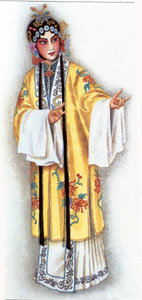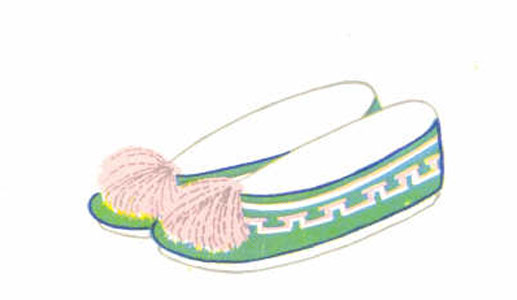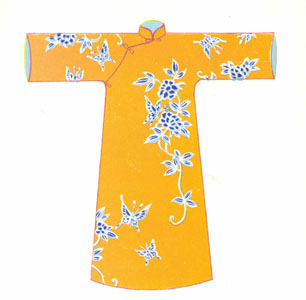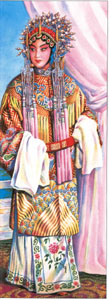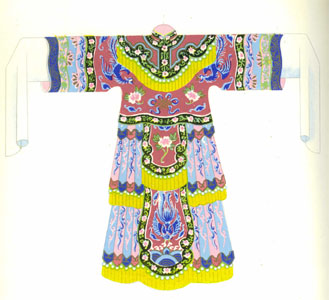About Cantonese Opera:
Costumes
This page co-authored by Stacey Fong and
Erick Lee
Back to About Cantonese
Opera Main Page
Cantonese Opera
costumes are colorful, intricate, and unique. Each type of character has a
variety of costumes to select from, so costuming is very flexible and up to the
performer. A performer chooses his/her costume depending on the
choreography of the show or personal preference.
Men's Costumes
Mun Plays
Most of the costumes in Mun
plays have water sleeves. Costumes tend to be long, almost like
robes. They can either be tied at the waist or left straight down.
There are many different types of cuttings; some are double breasted and tied on
the side, while others are single breasted and button-down. Some have
round collars and are buttoned around the shoulder. The types of costumes
for men include, but are not limited to:
Hoy Ching - Normally it is worn by scholars, and can also serve as
leisure wear. Hoy Ching can be tied at the waist with tassels.
Commoners of the town or city can wear hoy ching, but it will have less
embroidery and less vibrant colors, symbolizing their poverty. The
hats usually worn with hoy ching are Fok Yer Gun, Yut Jee Gun,
and Yern Gun.
Mun Goon
Po - This is worn by officials who are not in court.
Mun Goon Mo - the hat worn with Mun Goon Po. Has the same embroidery as
the Mun Goon Po, with two pointed "wings" on the sides.
Pay Fung -
Usually worn by old scholars or old officials at home.
Saa Mo - the hat worn with Pay Fung, it is black velvet and has two rectangular
wings.
Pay Fung can also be worn with a box like hat, with the same embroidery as the
pay fung. This style is usually worn by older men.
Mong -
Worn by officials in court. The gok dai is a ring or hoop around
the waist, which is a symbol of rank. Mong can also be worn by a king, but
will have "royal" embroidery, such as dragons, and the fabric is often
yellow with golden threads. A Mong can also be worn by a general,
who is not in battle. In this case, one sleeve will be a water sleeve, and
the other will be cuffed (called Mun Mo Sleeves). The cuffed sleeve is usually the right.
Yoon Nang -
The same cutting as a Mong, but it is worn by lower ranked officials. It
has less embroidery, usually just a round or square pattern on the chest.
Dai Hon Jong
- This is a very general cut and design, worn during the Han dynasty. It
has big, wide sleeves, and a pleated skirt. This style, or a variation of
it, was worn by almost everyone in that dynasty.
Mo Plays
Costumes
in Mo plays are usually more elaborate than Mun. There are also more costume
accessories.
Dai Kow - One of the biggest, heaviest, and grandest costumes in Chinese Opera,
the dai kow symbolizes armor that a general wears. A Fu Pai is the large
plate of armor covering the torso. This extravagant costume includes of
four pennants worn on the general's back. The pennant serves as general's seal or official signature.
Siu Kow -
This is also a costume worn by a general, but toned down from the dai kow.
It consists of a lot of different pieces and layers, and is tied at the
waist.
Jo Mah - Can
be worn by general or any character in Mo. There are many different
accessories which can be worn with a Jo Mah, for example, a baan dai, or kwun
sok.
Baan Dai - A waistband that hangs down to the ankles. The performer
incorporates the baan dai into their movements.
Kwun Sok - A thin rope with very long tassels, it is tied across the chest in
different ways to form different patterns on the performer's torso.
Ging Jong -
Basically a shirt and pants, can be worn with either baan dai or kwun sok
(usually baan dai). Usually worn by lower ranking generals, or commoners
in Mo scenes.
Hats/Helmets
worn with Mo costumes - Many have colorful pom poms and/or rhinestones.
These helmets also can have the pheasant feathers attached to them. Helmets
include, but are not limited to, Dai Ngak Ji (usually with dai kow), Ji Gum Goon (usually with dai kow), and many
others.
Women's
Costumes
Mun Plays
Almost all of the ladies' costumes
have water sleeves in Mun plays. Costumes are usually made up of a shirt,
either buttoned down the front or back, and a long, flowing skirt. The
ladies' costumes tend to be less diverse and interchangeable than men's costumes
because a lady's costume (and hair) will tell a lot about her status.
Maids and/or poor girls usually wear a shirt and pants set. The more
embroidery there is on an outfit, the richer or high in social status that
female will be.
Siu Gu
Jong - a shirt and blouse set that is tied at the waist. Generally worn by
unmarried girls, and simpler versions can be worn by maids.
Pay Fung
- usually worn by married women, this is a blouse and skirt outfit that is not
tied at the waist.
Mong -
worn by royalty at a formal gathering, such as a party.
Mo
Plays
Like men's costumes, women's mo costumes are far more elaborate than in mun
plays. There are also numerous accessories which can be worn with the
costumes.
Dai Kow - One of the biggest, heaviest, and grandest costumes in Chinese Opera,
the dai kow symbolizes armor that a general wears. A Fu Pai is the large
plate of armor covering the torso. This extravagant costume includes of
four pennants worn on the general's back. The pennant serves as general's seal or official signature.
Siu Kow -
This is also a costume worn by a general, but toned down from the dai kow.
It consists of a lot of different pieces and layers, and is tied at the
waist. Girls' Siu Kows can have two different types of skirts.
Bay Kwun - Three knee length flaps that hang from the girl's waist.
Jok Yeep Kwun - This skirt consists of many thin flaps that look almost
like long leaves (in Chinese, yeep means leaf), hanging down to the floor.
This style is usually worn by females who are pushing a carriage.
Hats/Helmets
worn with Mo costumes - Many have colorful pom poms and/or rhinestones.
These helmets can also have the pheasant feathers attached to them.
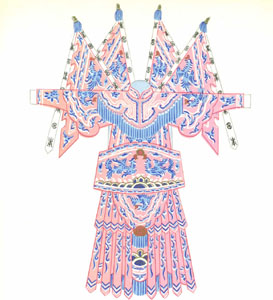
Dai Kow with the Pennants and Fu Pai. Skirt style utilizes Jok Yeep
Kwun.
From Chang,
Ta-hsia. See reference page
for book details. |
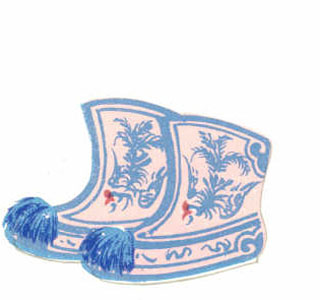
Jeen Hur - Worn by female warriors.
From Chang,
Ta-hsia. See reference page
for book details. |
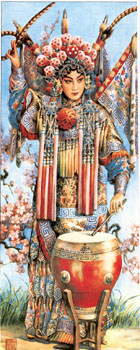
Female general wearing Dai Kow with pheasant feathers and chestbuckle.
From Chinese Opera Characters. See reference page
for book details. |
|
[Home]
[About
Cantonese Opera] [News & Events] [ABC
Corner] [NBC
Corner] [CBS
Corner]
[Editorials] [Spotlight on...] [About
this site]
©
2002-2003 Bay Area Cantonese Opera. All rights reserved.
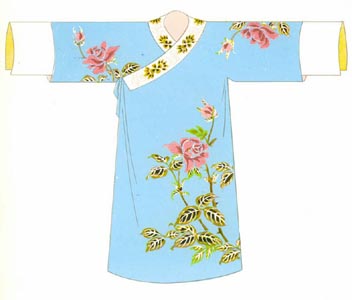
.jpg)
